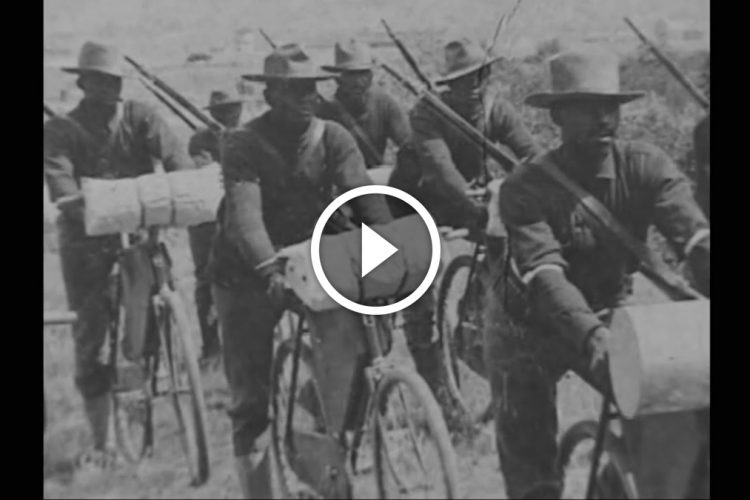
So you want to try bikepacking. Do you have a bike? (duh…) A route? (ya!) Loads of unbridled, rookie enthusiasm? (of course!!) Loads of money for high-tech, hard-core, ultra-light, fancy-schmancy gear to sleep in and on, cook with, provide light, and strap it all to your rig for miles on end? (uh… nope).
Just like enduro and fat biking opened the market to more technology to meet different needs, bikepacking is another special case requiring the right set of tools to get the job done. Bikepacking is far more unique than the aforementioned styles of riding in that you must have certain gear to survive versus detachable chin guards and goggles that, while maybe making your ride slightly more enjoyable, will probably not make or break your performance. So unless you’re already an ultra-lightweight backpacker, the appropriately durable, comfortable, weight-minded gear required for bikepacking is going to set you back a few pennies.
Unless you’re down with D.I.Y.
Making (and using) your own stuff is fun, rewarding, and most importantly, cheap! Cheap is good when you’re just getting started, so you can experiment and then rest assured when it’s time to upgrade your organic gear. Cheap is also good as it saves you the heartache if your arts and crafts fail.
DIY Shelter
It just so happens that shelter, one of the most important, sometimes bulkiest, and potentially most expensive items on your bikepacking gear list, is completely DIY-able for a fraction of the price of the commercial products available. In fact, some to all of the ingredients to cook up today’s refuge of interest might be collecting dust in your garage right now. What is this homegrown haven? The hammock!
Hammocks can be lighter and quicker to setup than most tents, are more comfortable than sleeping on the ground, require virtually no hardware, and are the only legitimate sleep system that you can easily construct yourself (aside from just staking out a tarp–but you’re still on the ground). Plus, who doesn’t love lounging in a hammock as it sways you back and forth into a silent slumber?
Supplies
The most basic hammock requires five items, some sewing (optional), and knot knowledge.
1. Tablecloth: hem the short ends of a 60 x 126″ tablecloth, leaving about an inch of space within the hem. This portion will be non-load bearing, so a simple single stitch will suffice. I am demonstrating with a heavier polyester fabric, but you may want to consider other lighter materials such as rip stop nylon.

2. Zip ties: Thread a zip tie through the hem and cinch tight. These are not required to bear load, so the length and width of the zip tie do not matter as long as it clears the gathering easily.


3. Rope: cut two pieces about 36-48″ long and join the ends together using a double fisherman’s knot. Use rope that doesn’t stretch (I use paracord). These are called continuous loops and are fastened at the gathered ends of the hammock (below the ziptie) using a lark’s head knot. The loops will join the suspension straps at the toggle.
Note: 3-4 feet of rope is plenty long, and you will modify as you see fit.


4. Nylon webbing: tie a bowline at one end of two pieces of 1″ x 8-10′ long nylon webbing. These are the tree straps (suspension) securing the hammock to the tree. The smaller the loop, the better to allow more slack when working with longer hangs.

5. Sticks: yes, sticks (or a dowel). These serve as toggles to join the loops and suspension when combined with a marlinspike hitch. Two sticks about 1/4″ x 4-6″ should do.

Steps to Setup a Hammock



Hang loops over toggle
2:21min Video Demonstration of the Setup Process:
Other Considerations
Exposure
In all fairness, the DIY hammock described here is not all you will need for every outing during any time of the year, as it still leaves you exposed to rain, bugs, and heat loss. Nevertheless, it is just as easy to DIY a custom rain fly, bug net, and insulation to fit your needs. Although this hammock is limited to warm weather bikepacking, so are other shelter options without the above considerations, so it’s basically a wash in terms of bulk and weight.
Modifications
Also keep in mind the many, many variations on a hammock theme. For example, instead of gathering the ends with a zip tie, you may choose to hem a heftier load bearing stitch and run the continuous loop through the hem, obviating the need for a zip tie and giving it a tidier look. If you’re not handy with a needle and thread, you can skip the hem altogether and whip the ends of the hammock. Perhaps the most interesting modifications occur where the suspension straps connect to the continuous loop. There’s a handful of hardware that can be used to avert knots, making it easier to adjust suspension and add a little bling in the process (pictured below). For other modifications and tips, click here.

PC: Derek Hansen from www.theultimatehang.com
Some Thoughts on Knots
Why these fancy, pain-in-the-rear knots? Well for one, they’re not that fancy. Some (or all) may be new to you, but once you do them three or four times they’ll be as easy as your trusty lace-up flats. Secondly, these are very secure and reliable knots that also release very easily (except for the bowline which you won’t have to untie anyway). As you put tension on the system, knots like the square or others tighten, making dismantling your hammock difficult and time consuming.
Your Turn: Use the comments section below for any questions, modifications, tips of your own, or to just let us know how you’re hanging!










3 Comments
Jan 30, 2017
Jan 30, 2017
"There’s a handful of hardware that can be used to avert knots, making it easier to adjust suspension and add a little bling in the process (pictured below)."
Jun 9, 2015